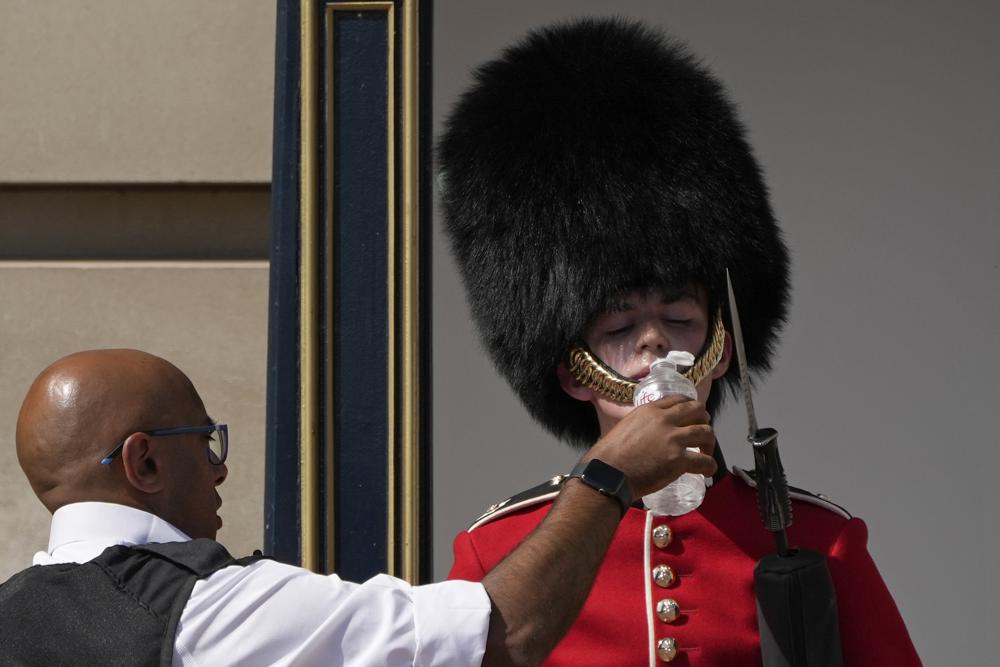A police officer givers water to a British soldier wearing a traditional bearskin hat, on guard duty outside Buckingham Palace, during hot weather in London, Monday, July 18, 2022. The British government have issued their first-ever “red” warning for extreme heat. The alert covers large parts of England on Monday and Tuesday, when temperatures may reach 40 degrees Celsius (104 Fahrenheit) for the first time, posing a risk of serious illness and even death among healthy people, the U.K. Met Office, the country’s weather service, said Friday. (AP Photo/Matt Dunham)
LONDON (AP) — Millions of people in Britain stayed home or sought shade Monday during the country’s first-ever extreme heat warning, as hot, dry weather that has scorched mainland Europe for the past week moved north, disrupting travel, health care and schools.
The red heat alert covers a big chunk of England and is due to last through Tuesday, when temperatures may reach 40 degrees Celsius (104 degrees Fahrenheit) for the first time, posing a risk of serious illness and even death among healthy people, according to the Met Office, Britain’s weather service.
The highest temperature ever recorded in Britain is 38.7 C (101.7 F), a record set in 2019. The country is not at all prepared to handle such heat — most homes, schools and small businesses in Britain do not have air-conditioning.
London’s Kew Gardens hit 37.5 C (99.5 F) by 3 p.m. and Wales provisionally recorded its highest-ever temperature, the Met Office said, a recording of 35.3 C (95.5 F) at Gogerddan on the west coast.
At least four people were reported to have drowned across the U.K. in rivers, lakes and reservoirs while trying to cool off.
While Monday may bring record highs to southeastern England, temperatures are expected to rise further as the warm air moves north on Tuesday, Met Office CEO Penelope Endersby said. The extreme heat warning stretches from London in the south to Manchester and Leeds in the north.
“So it’s tomorrow that we’re really seeing the higher chance of 40 degrees and temperatures above that,” Endersby told the BBC. “Forty-one isn’t off the cards. We’ve even got some 43s in the model, but we’re hoping it won’t be as high as that.”
Hot weather has gripped southern Europe since last week, triggering wildfires in Spain, Portugal and France. Almost 600 heat-related deaths have been reported in Spain and Portugal, where temperatures reached 47 C (117 F) last week.
Climate experts warn that global warming has increased the frequency of extreme weather events, with studies showing that the likelihood of temperatures in the U.K. reaching 40C is now 10 times higher than in the pre-industrial era. Drought and heat waves tied to climate change have also made wildfires harder to fight.
Officials in southern France’s Gironde region announced plans to evacuate an additional 3,500 people from towns threatened by the raging flames. More than 1,500 firefighters and water-bombing planes are trying to douse the flames in the region’s tinder-dry pine forests.
In Britain, train operators asked customers not to travel unless absolutely necessary, saying the heat was likely to warp rails and disrupt power supplies, leading to severe delays. Some routes were running at reduced speed or shutting down entirely from mid-afternoon, when temperatures were expected to peak.
Some medical appointments were canceled to relieve strains on the health service. Some schools closed, and others set up wading pools and water sprays to help children cool off. Most British schools have not yet closed for the summer.
The extreme heat even led Parliament to loosen its strict dress code. The Speaker of the House of Commons said male lawmakers could dispense with jackets and ties for the week.
The high temperatures are even more of a shock since Britain usually has very moderate summer temperatures. Across the U.K., average July temperatures range from a daily high of 21 C (70 F) to a low of 12 C (53 F).
But nightfall on Monday will bring little relief from the heat, with the Met Office forecasting temperatures of 29 C (84 F) at midnight in London. Monday night will be “very oppressive” and it will be difficult to sleep, Chief Meteorologist Paul Davies said.
“Tomorrow is the day where we are really concerned about a good chance now of hitting 40 or 41C, and with that all the health conditions that come with those higher temperatures,” he said.
Copyright 2021 Associated Press. All rights reserved.
Source: https://apnews.com/article/travel-england-weather-8b586506a278b2103562f361bcef5fda


























You must be logged in to post a comment Login